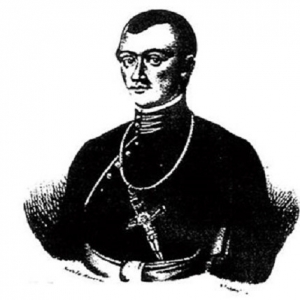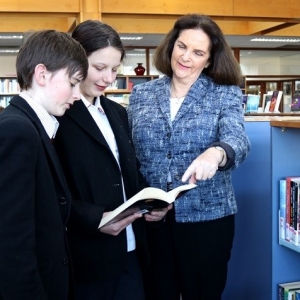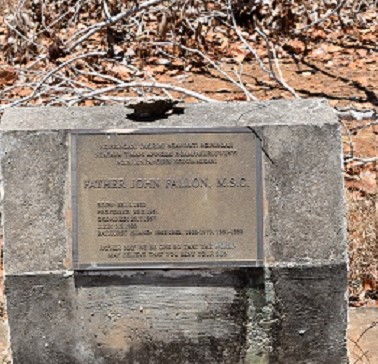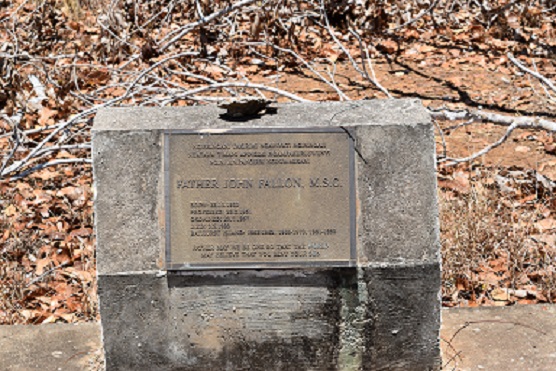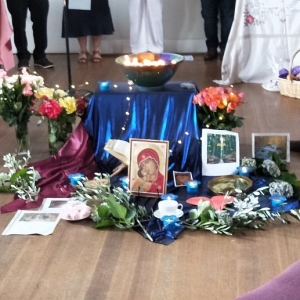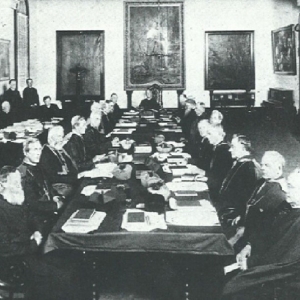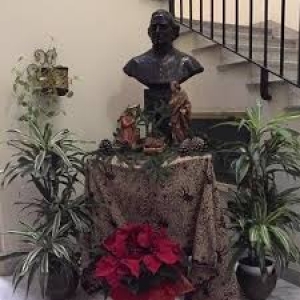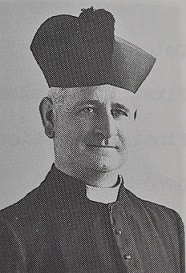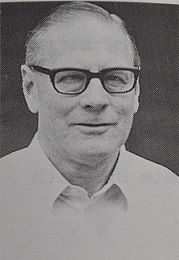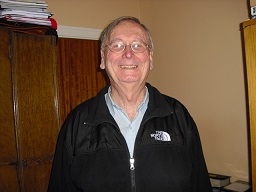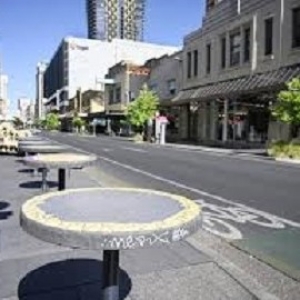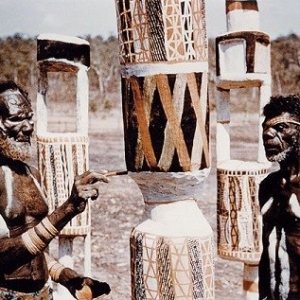Peter MALONE
Darwin ceremony: Bishop Charles Gauci and the Confalonieri Plaque
Darwin ceremony: Bishop Charles Gauci and the Confalonieri Plaque
Fr Malcolm Fyfe, Vicar General of the Diocese of Darwin has sent the following news.

On the First Sunday of Advent, November 29th at the 9.30 am Mass in St Mary’s Cathedral, Bishop Charles blessed a plaque commemorating Father Angelo Confalonieri and affix it to the wall inside the Cathedral.
Father Angelo Confalonieri, 1813-1848, was the first Catholic Priest in the Northern Territory and Missionary to the Aborigines of Cobourg Peninsula.
In conjunction with this ceremony, local members of the Order of Malta are arranging for a number of items associated with Father Angelo’s life to be on display at the back of the Cathedral.
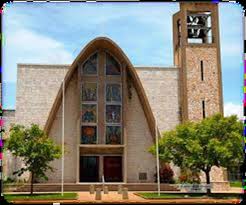
The following is the text inscribed on the plaque:
Father Angelo Confalonieri, 1813-1848, first Catholic Priest in the Northern Territory and Missionary to the Aborigines of Cobourg Peninsula.
Father Angelo Bernardo Confalonieri was born on 13 June 1813 in Riva del Garda, in the province and diocese of Trento, Northern Italy – in those days the region was known as the South Tyrol, and was part of Austro-Hungarian Empire. After becoming a priest, Father Angelo volunteered to serve in the Missions, and prepared himself physically in the mountains of his region undergoing extreme tests by bouts of fasting and subjecting himself to extreme conditions of cold and heat. During a period of spiritual preparation at the Propaganda Fide College in Rome, Father Angelo met Monsignor John Brady, who had been appointed Bishop of Perth, with pastoral responsibility for Western Australia, including the Northern Territory. Bishop Brady recruited a large group of European missionaries, who were willing to help build the Catholic Church in Australia at the time of white colonization of the country.
Father Angelo Confalonieri joined this group of missionaries, who set out from London on 15 September 1845 and arrived in Perth on 8 January 1846. In Perth Bishop Brady entrusted the Vicariate of Port Essington to Father Confalonieri. In Port Essington on the Cobourg Peninsula the British Marines had recently established a military outpost “Victoria Settlement”. Two Irish catechists, James Fagan and Nicholas Hogan were asked to accompany Father Confalonieri.
The three missionaries left for Sydney, where they were able to obtain some financial assistance to purchase goods for the mission. They then embarked on the ship “Heroine”, which with another two ships, carried supplies for the garrison in Port Essington.
While crossing the Torres Strait (between Cape York and New Guinea), on the night of 24 April 1846, the Heroine struck a submerged coral reef, and sank in a very short time. Many of the ship’s passengers drowned, including the catechists Fagan and Hogan. (In the crypt of this cathedral there is a plaque in memory of these two catechists). Father Confalonieri, who could not swim but was on the deck praying, was able to save himself by clinging to a rock. The next day the surviving passengers were picked up by one of the other boats of the convoy and taken to Port Essington.
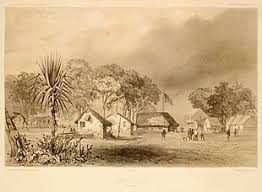
At Victoria Settlement, Father Confalonieri soon gained the respect of the Commandant of the garrison, John Mc Arthur, who helped the missionary with clothes and provisions. McArthur also assisted Father Confalonieri in his endeavours to approach the local Aborigines. With the help of the marines, Father Confalonieri established his base in a hut at black Rock, at the entrance to the harbor, several miles away from the military outpost of Victoria Settlement. And with the support of McArthur and the British soldiers, Father Confalonieri was able to dedicate his time and efforts to the Aborigines.
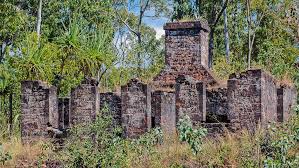
This courageous missionary adopted the nomadic lifestyle of the local native population, shared their daily life, and acquired a good knowledge of the language of the Iwaidja tribal group. He drew up a map of the area, outlining the various tribal groups that occupied the Cobourg Peninsula; this map is preserved in the Latrobe State Library in Melbourne. Father Confalonieri also wrote a small dictionary and phrase book in English and in the Iwaidja language, including some prayers; this booklet and other documents are now preserved in the library of the Propaganda Fide College in Rome. Near his hut, Father Confalonieri built a small field hospital for the Aborigines.
However the nomadic life, the loneliness and isolation, the climate and changing seasons, the lack of medicines, the poor diet, and the absence of contact with the Church all contributed to undermine and weaken his physical and mental energies. After two years of this existence at Port Essington, Father Confalonieri was struck by a serious fever most likely caused by malaria. Captain McArthur had him transferred to the Victoria Settlement hospital, where Father Confalonieri died, on 9 June 1848, aged 35 years. Two days later, he was buried in the local cemetery, with full military honours, out of respect for a man who had greatly earned the esteem and affection of the whole garrison.
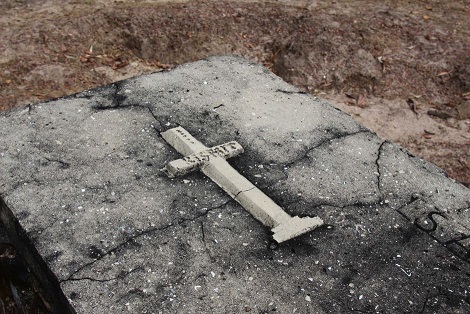
Said to be Fr Confalonieri's cross
Announcing Father Confalonieri’s death, Archbishop Polding of Sydney described him as “a most excellent missionary”; and Dom Rosendo Salvado (who had travelled with Father Confalonieri to Australia, and established the Benedictine Mission at New Norcia) wrote of him as “a young man of high intelligence and saintly life, whose death was mourned by all those who had the good fortune of knowing him”.
Some Signficant December Days for the Chevalier Family, 2020.
Some Signficant December Days for the Chevalier Family, 2020.

December is an important month for the Chevalier Family. 8th December, the anniversary of the foundation of the Congregation, 166 years ago.

11th December, the Spanish priest, Gaspar Garcia Laviana MSC, killed in the fighting year, 1978, in Nicaragua.
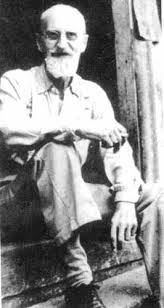
27th December, birth of Archbishop Alain de Boismenu.
3 December, 1970
Father Louis Vangeke, MSC, the first priest of PNG, appointed auxiliary of Port Moresby, is ordained Bishop by Pope Paul VI, in Sydney, Australia.
5 December, 1829
Birth of Emile Sebastian Maugenest, in Culan, France.
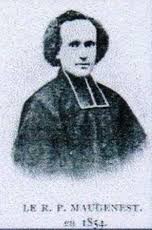
8 December, 1854
Father Chevalier and Father Maugenest end their novena to the Blessed Virgin.
It was planned to conclude on the day that Pius IX proclaimed Mary’s Immaculate Conception.
Father Chevalier always considered this day as the foundation day of the MSC Congregation, and it continues to be so today.
8 December, 1865
Beginning of the Annals of Our Lady of the Sacred Heart in France.
8 December, 1956
The Missionaries of Christ (MC) are founded by father C. Moser, MSC, in Germany. This is a community of religious missionary women, and it continues to exist today in six countries ~ Germany, Austria, Siberia, Congo (RDC), Brazil and South Africa.
8 December, 1982
On the occasion of the centenary of her entrance into the novitiate and nomination as FDNSC Superior, the body of Mother Marie-Louise Hartzer is transferred to the Crypt in the Basilica in Issoudun.

9 December, 1954
Profession of the first Peruvian MSC Sisters in Lima, Peru.
11 December, 1978

Father Gaspar Garcia Laviana, of the MSC Spanish Province, is killed in Nicaragua.
17 December, 1853
E.S. Maugenest, 'co-founder' with Father Chevalier of the MSC Congregation, was ordained priest at Saint-Sulpice, Paris.
Maugenest left the MSC Congregation on 31 December, 1871, after being parish priest in St Cyr for 10 years.
He entered the novitiate of the Dominican Fathers and ended his days as a Dominican. He and Chevalier always remained good friends.
25 December, 1856
First (private) vows of Father Chevalier and Father Maugenest.
27 December, 1870
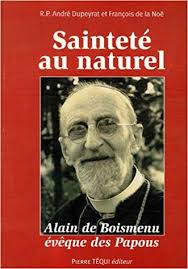
The birth of Alain G. de Boismenu in Saint-Malo, France. He was Vicar Apostolic of PNG from 1922-1946 and later Titular Archbishop. His cause has been put forward for beatification.
28 December, 1864
At four o'clock in the morning Father Victor Jouët arrived in Issoudun for the first time and discovers the statue of Our Lady of the Sacred Heart. "... I fall at the feet of your enchanting image, and I stand up as your missionary for life. In one second, what a grace!"
Rita Daniels, concluding her term as Principal, reflects on her years at Daramalan College, Canberra
Rita Daniels, concluding her term as Principal, reflects on her years at Daramalan College, Canberra

The new Principal of Daramalan College from January 2021 will be Mrs Rachel Davies. This provides an opportunity for me to reflect on what has been a long, varied and very rewarding career as a teacher and as a Principal, including the last twelve years as Principal of Daramalan College.
My first experience of Daramalan College was late in 1979 when Fr Jim Littleton msc employed me as a teacher. At that time Daramalan was a boisterous and very male-dominated school which had female students enrolled only in Years 11 and 12.

There was a lot of energy and spirit in the school at that time and it did not take long for me to feel that I was quite at home there.
For the next twenty years I worked at Daramalan in a range of roles within the College which all provided me with great opportunities to learn and grow. Following Fr Jim’s departure, I worked under the leadership of Fr Jock McCowage, Fr Bob Irwin and Fr Denis Uhr and finally Frank Fulton who all brought different gifts to their roles. I saw and experienced many changes within the College itself as well as in education over this time that helped to shape my thinking as an educator. Perhaps one of the most significant changes for Daramalan during this timewas the decision to close the Junior School and become co-educational in Years 7-10 which occurred in the mid-1990s. This proved to be an excellent decision for the school in a variety of ways and we have been reaping the benefits of it since then. There was a very strong MSC presence in the school during those years and I think many people did not anticipate this changing as quickly as it did.
I left Daramalan at the end of 2000 to become Principal of St Clare’s College, Canberra. At the time I left I never envisaged returning to work at Daramalan but I did retain close ties with a number of staff and I remained in an Associates group led by Fr Jim Littleton msc so my connection to the school and the MSCs continued during these years.

I returned to Daramalan as Principal in 2009. I was very warmly welcomed back and offered great support in my role as Principal which enabled me to quickly take on the role that was to be very demanding yet rewarding over the next twelve years. I wish to acknowledge particularly the unfailing support of Fr Jim, Br Barry Smith and Fr Harold Baker as well as all the people who were part of the College’s Executive team and the College Board over the twelve years. I have also enjoyed a long and valued friendship with Fr Bob Irwin and other members of the MSC Education Committee as well as the Chevalier Institute staff during this time. All these people have made my job a lot easier, especially in some of the difficult times.
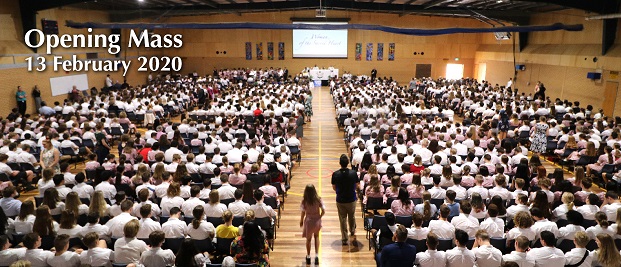
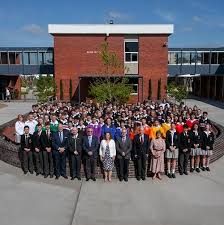
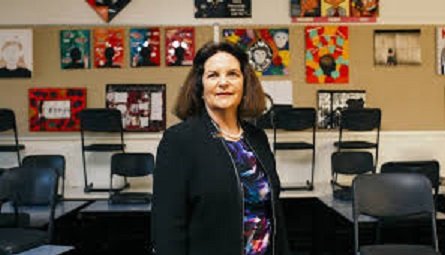

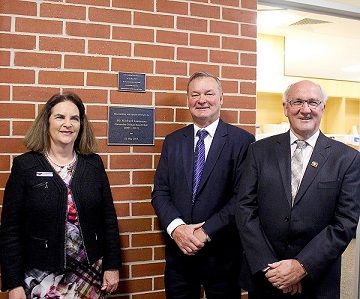
A Tiwi Islands, MSC, culture story, Part 3, ‘The conversion of John Fallon’.
A Tiwi Islands, MSC, culture story, Part 3, ‘The conversion of John Fallon’.
Converting the Church
Non-indigenous accounts of a "conversion" of the Church in the 1960s invariably turn to the Second Vatican Council. The Council itself has been described as "an event of conversion." The council's call, not only to respect other cultures, learn from them, propelled a shift in missiological theory and practice. It was Eurocentric. Yet it presented opportunities for the Church to embrace cultures and approaches from beyond Europe.
Nostra Aetate, for instance, taught that the Catholic Church "rejects nothing of what is true and holy" in non-Christian religion. Nostra Aetate opened possibilities for infusing the liturgy with Aboriginal symbols. Sister Robyn Reynolds, from the nearby Wadeye Aboriginal mission, argued that the Easter Wadeye Baptism, replete with Aboriginal symbolism, was a response by Aboriginal people to the call for liturgical inculturation. Aboriginal leader and former Missionaries of the Sacred Heart (MSC) priest, Patrick Dodson, also remembered the Council opened opportunities for encounters between Aboriginal ritual practices and the Roman rite (though he was ultimately disappointed, believing that, in Australia, the Council's vision of the "community of believers" drifted back to "hierarchy ... conformity and compliance").
When Fallon published an account of his "conversion" in a missionary magazine in 1991, he placed it firmly in the context of the Vatican II reforms. He likened his experience to St. Paul's and called it his "metamorphosis." His version has many similarities to Tiwi memories. The Pukumani had drawn people away from mass, so he disrupted it:
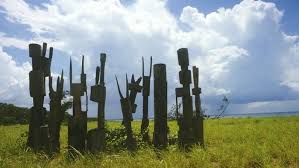
"It was a Sunday. There was nobody in the church - only a few - and I could hear the sounds of a Pukamani [sic] coming across the Aspley Strait from Paru, on Melville Island. My Mass was totally distracted - and made short! I got myself across the strait and immediately scolded the people in good dramatic language with all the show of anger and shame that I could muster. This was early in my zealous days. I even shook one of the sacred posts, belonging to Minnipinni, Thomas Woody's father. He asked me to stop. I didn't. Such a pagan symbol deserved shaking, just as they all did!
"I'd forgotten this part, but Thomas Woody reminded me in 1986 ... Within a fortnight of this happening I was on my way over to Paru once more ... when I lost a brand new Mercury 25HP outboard motor, over the side of the boat, never to be retrieved. So I was duly punished for shaking that post, according to Thomas."
Fallon did not mention who or what "punished" him. Did he believe in the mobuditi? Perhaps. Versed in St. Paul's dramatic conversion, Fallon might have understood that the mobuditi broke into his experience in a similar way, creating a spiritual rupture, turning him from misplaced zeal towards a deeper truth. Yet Fallon claimed he had forgotten this part of the story, so crucial in Tiwi versions. Writing for a non-Indigenous readership, perhaps uncomfortable with the possibility that a priest could experience the Tiwi spiritual world as a living reality, he attributed his change to intellectual reflection more than supernatural intervention.
Soon after these events, Fallon left the islands. This, he said, gave him the space to rethink his approach to mission. When he returned, the teachings of the Second Vatican Council were fresh in his mind - that is, "we enculturate Jesus' word with [other] cultures." For him, his conversion happened over a period of years, formed from reflection on his experiences with the Tiwi and the ideas coming from Rome.
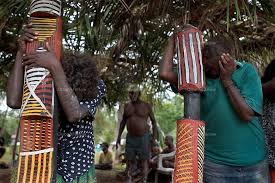
The priests in the Northern Territory were intrigued by the cross-cultural opportunities of Vatican II. One reflected on the new thinking in the early 1970s. Pastors must "study the culture" in which they work and understand whether their liturgy is "attuned" to the people. Fallon suggested that the "Roman Rite" needed a more thoroughgoing cultural translation for the Tiwi context. He embraced ideas about what came to be called "inculturating" the Gospel. He not only learned to dance in the Tiwi way, but led a movement to bring the Pukumani into the Church.
In 1968, Fallon arranged for the installation of Pukumani poles in the Bathurst Island church; the legs of the altar would be made of six miniature poles. By 1975, missionaries were discussing including Pukumani dances in the funeral mass, including blessing the poles. These moves, they believed, would make Catholicism more comprehensible and attractive to Tiwi.
Perhaps it was simply coincidence that Fallon's conversion experience at the Pukumani took place during this period of "conversion" of the global Catholic Church. Yet, it could also be said that it was the Tiwi people - or even the mobuditi spirits - that caused the conversions of Vatican II to come alive in North Australia.
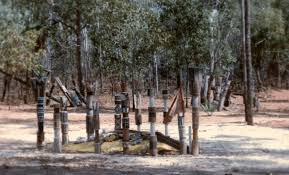
"God gave us culture, Tiwi culture"
On the question of their "conversion," the Tiwi acknowledge that they changed upon contact with missionaries. There was a time, before the mission, when they were not baptised and they did not know Catholic teachings. They speak quietly of "bad things" that they no longer practice. For Tiwi, these were not abandoned simply because missionaries insisted - missionaries, for instance, misjudged the Pukumani as a "bad thing" - instead, through discussion with missionaries (and not without conflict), Tiwi people decided they need not be intrinsic to their culture. They emphasise that Catholicism is perfectly consistent with Tiwi culture - "God gave us culture, Tiwi culture" - so it would be incorrect to consider their ancestors "pagan."
There has been some blending of ritual practice and story, led by Tiwi themselves. Tiwi people made parallels between Purrukapali and Adam, the Moon-Man and Christ in the 1960s. In the 1980s, Tiwi compared the Catholic service to their rituals, commenting, for example, that the use of incense in church was similar to their use of smoke. Tiwi women's songs include Catholic hymns translated into Tiwi. Other songs blend traditional Tiwi and Catholic spiritualities.
Despite these examples, I found Tiwi people reluctant to integrate Catholic and Tiwi ritual and story. An older woman explained to me that "we got two: Christian faith and our culture." Another explained that there is only piecemeal integration of Tiwi culture in the church, though she hoped it would become deeper. When I asked if there were parallels between biblical stories and the Purrukapali story (could, for example, Purrukapali be a Tiwi Adam?) I was told, "we've gotta still work it out"; there is a reluctance to make explicit parallels as priests have done. Some insisted that biblical stories were not equivalent to their stories.
From a missiological perspective, inculturation was always meant to be more than evangelising cultures in a "thin veneer" (to use the words of Pope Paul VI). The priests, no doubt, thought they were creating this deep engagement when permitting the Pukumani poles in church. Yet according to some Tiwi, there is remains a ritual shallowness to this engagement in the church. Yet this does not threaten their Tiwi Catholic identity, it points to the failure of the Church to convert fully to the Tiwi world.
From my understanding of the Fallon story, Tiwi Christianity meant - and means - waiting for the Church to change and turn to them, to overcome its homogeneity in favour of their localism and become embedded in their islands. As they insist through the Fallon story, especially his dancing, the real conversion was that of the Catholic Church becoming Tiwi.
The insight of the Tiwi perspective on conversion is that for people to become part of spiritual communities, the community and its spirituality change. Religious institutions themselves can be converted as the very people they include interpret their faith different ways. Tiwi memories reveal that, as the Church incorporates more peoples, it changes and grows. As it turns and embraces new peoples and cultures - even their ancestors and spirits as the Tiwi recognise - the Church is, in a sense, converted to them.
Laura Rademaker is a Postdoctoral Research Fellow in the Australian Catholic University's Institute for Religion and Critical Inquiry, and author of Found in Translation: Many Meanings on a North Australian Mission
Heart of Life Centre, Siloam, Spiritual Direction Program, 2020, Graduation.
Heart of Life Centre, Siloam, Spiritual Direction Program, 2020, Graduation.

2020 and Covid-19 has been a very difficult year for us all – but, especially, in Melbourne with so much lockdown, especially from July to November. It meant that, apart from February, Siloam was a Zoom course this year.
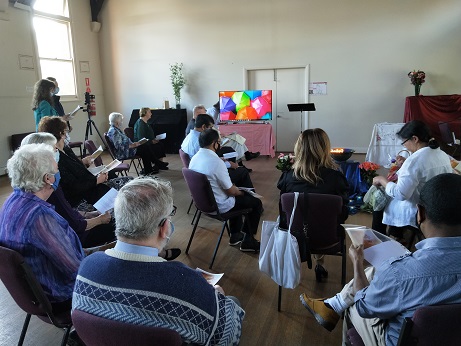
Our participants in the full-time program came from India (an SVD and an SDB priest), a Columban from the Philippines, a Carmelite from East Timor. There were seven fulltime participants and four completing the second year of the part-time program.

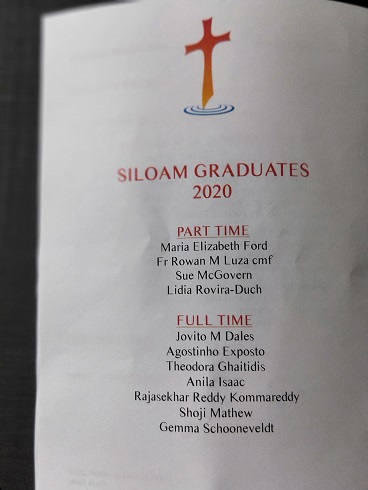
Previously, we celebrated Graduation with a Mass at St Paschal’s Box Hill. But, with our having to move out of Box Hill this year, we were offered hospitality by the Anglican Church of St George in Malvern. But with prohibition of gathering, our spiritual directors had to do their work and study by distance and online,
Just weeks ago, we were regretting that we could not meet to end the year.
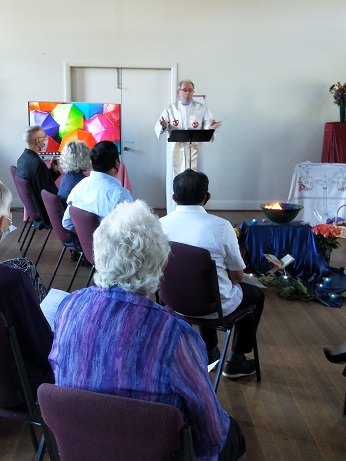
However, Melbourne coming through the pandemic restrictions, it seemed something like a small miracle that we (staff and participants) could actually gather at St George’s hall. It was last Monday, the first day when more than 20 people could gather. We had a ceremony, readings and prayer and the presentation of certificates. Paul Castley presided.
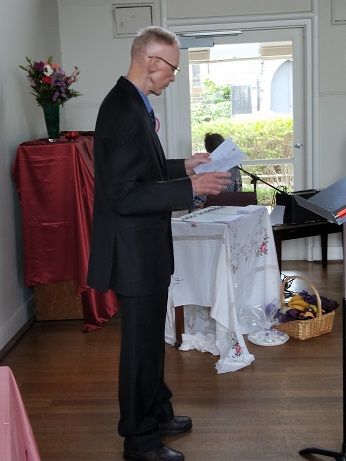
Director of Heart of Life, Paul Beirne, presided. While photos were taken, the ceremony was filmed for the many family members who could not attend, from Australia, bur, especially from overseas.
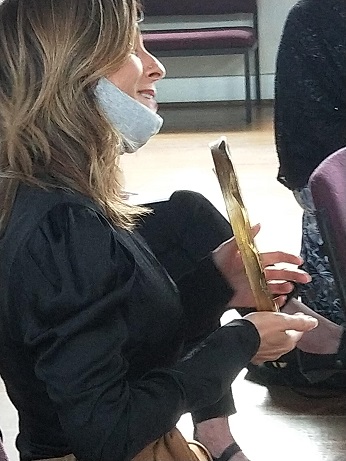
Dora (Theodora) Ghaitidis is a member of the Greek Orthodox Church
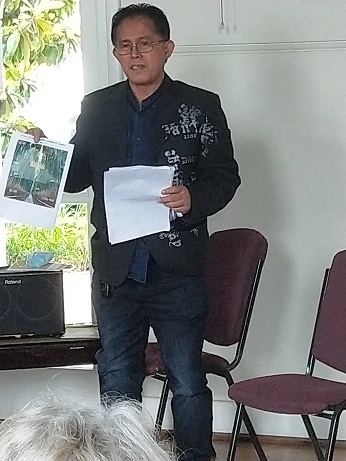
Rowan M. Luza cmf is from the Philippines but works in the Melbourne parish of Ardeer
Each of the participants presented and spoke to a symbol of the year. Each of the participants received a Graduation Certificate.
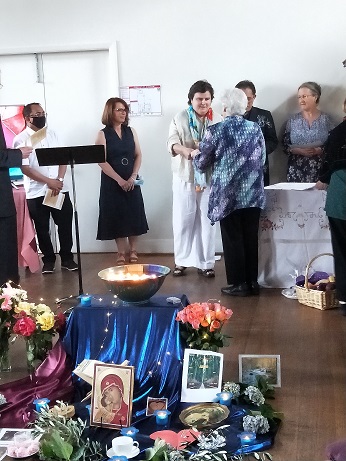
Sue McGovern RSJ is from Adelaide
Heart of Life is an MSC ministry. Paul Castley has been on the direction team for the Spiritual Leaders’ program. Peter Malone is responsible for the Religious Experience unity. Philip Malone represented the Provincial. Robyn Reynolds is responsible for several courses, including Grace.
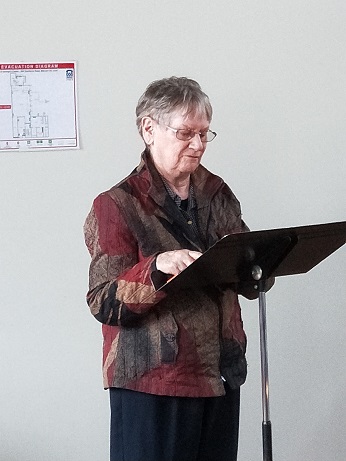
Robyn Reynolds OLSH
Musician and singer, Maria Forde, composed a special hymn, Heart of Life – we will feature the lyrics and the music in the coming week.
A happy ending for a challenging year at Heart of Life.
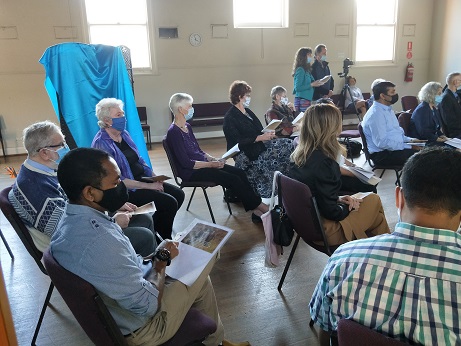
Despite the masks.
MSC presence at the 1937 Plenary Council: Aboriginal missions in the Diocese of Victoria and Palmerston, NT, 1905 to 1937
MSC presence at the 1937 Plenary Council: Aboriginal missions in the Diocese of Victoria and Palmerston, NT, 1905 to 1937
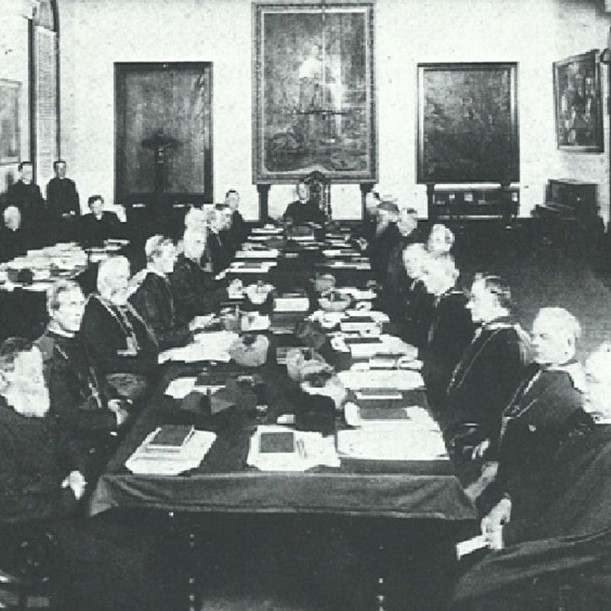
From the history and research by Peter Wilkinson, published in The Swag.
Australian-born Bishop William Kelly of Geraldton had asked to be relieved of the administration of the vacant (since 1888) Diocese of Victoria and Palmerston (NT) at the 1905 Plenary Council. He was given this responsibility in 1898 when the Jesuits could no longer support their Aboriginal missions. After the last Jesuit left the diocese in 1902, Kelly stationed one of his priests there for a time, but when he returned to Geraldton the small local Catholic community had to rely on priests passing through.
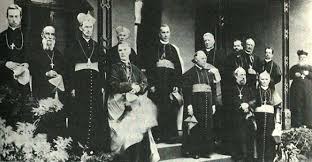
At the 1885 Plenary Council, the Missionaries of the Sacred Heart (MSC), with charge of the Vicariate Apostolic of Melanesia and Micronesia, had sought and received approval to establish a missionary seminary in Sydney and in 1904, a novitiate at Douglas Park (NSW). In 1906 they established an Australian province and German-born Fr Francis Xavier Gsell MSC was appointed apostolic administrator of the Victoria and Palmerston Diocese (NT). It was intended that he would resume the former Jesuit mission to the Aboriginals at Daly River and expand Catholic ministry in Darwin.
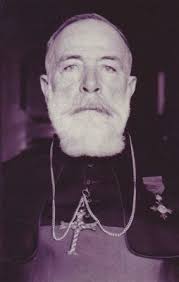
In 1911, the MSC congregation was offered the Pallotine Beagle Bay Mission in the Kimberley Vicariate, but turned it down. Gsell preferred to open a mission to the Aboriginal people on Bathurst Island instead and the same year organised a multinational group of MSC missionaries for the Tiwi Mission. Unlike the Pallotines, Gsell could rely on a good supply of Australian-born missionaries from the Sydney seminary, and were not subjected to the same strict surveillance during the war years.
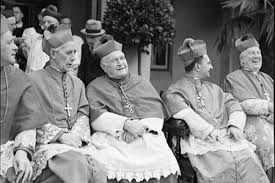
Gsell’s mission policy on marriage closely followed that of the Jesuits: Aboriginals should not marry Asians, whether Macassans, Japanese or Filipinos. When racial conflict erupted at Caledon Bay in the 1930s, Gsell became fearful for the Tiwi mission. He sought and obtained permission to open new missions at Port Keats (later moved to Wadeye) in the Daly River district in 1935, at Alice Springs (Little Flower Mission, later Santa Teresa Mission) in 1935, and at Tennant Creek (a Pine Creek parish opened in 1907 had languished) in 1936.
Gsell attended the 1937 Plenary Council as Apostolic Administrator of Victoria and Palmerston Diocese.
Australians who were members of the MSC General Administration.
Australians who were members of the MSC General Administration.
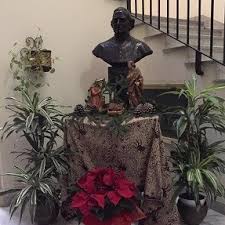
We have posted some items on Australian MSC in Rome, those who studied there after World War II as well as the Brothers who staffed Via Asmara, the Generalate. This time MSC in world administration.
Two MSC were members of the General Council before World War II. After the war, two became Superior General and three were members of the Council. Also three acted as secretaries for the Superiors General.
- Matthew Smith, Assistant, 1920-6
- Harold Bridgewood, Assistant, 1926-1937
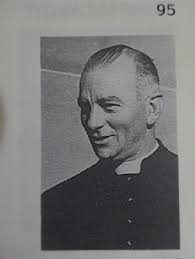
- Patrick McCabe, Superior General, 1947-1957
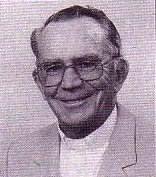
- E.J. Cuskelly, Superior General, 1969-1981

- Dennis Murphy, Assistant, 1981-1993.

- Christopher McPhee, Assistant, 2011=2017
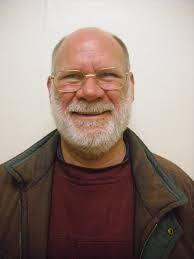
- Christopher Chaplin, Assistant, 2017-
Secretarial work:
Leo McDougall for Fr McCabe
Paul Stenhouse for Fr Cuskelly

John Bosman for Fr Kees Braun.
South Australia Lock-Down November 19 – 24 Noel Mansfield MSC
South Australia Lock-Down November 19 – 24
Noel Mansfield MSC
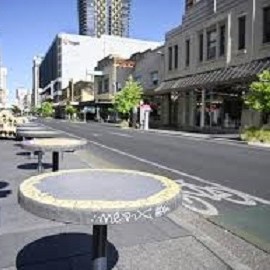
There has been an outbreak of Corona Virus in parts of Adelaide during the past week. It has only been in restricted areas. However, the Government has decided it is better to be on the safe side with this new surge.
It is a very strict; lockdown. Churches, schools, hotels, gymnasiums recreation and other parts have been closed completely. Schools will be opened only for children of essential services. It is drastic but seemingly necessary.
Over the past couple of days, there have been no new cases of the virus. There are some who are now saying that there is great pain for very little gain.
It is not my intention to write about the pros and cons. I do not want be the judge of this. Yet I would like to express what it is like to go through a very strict lockdown.
The first thing that strikes me is the silence. There are some cars and buses running along Seaview Road.

Some cars are parked along the street, these are the exception. This is usually a very busy and noisy road. Now it is just the reverse.
The telephone in the house is normally a constant part of the noise. A very significant part of the silence is the absence of constant phone ringing. Our phone system rings at every phone that is in every room. So the constancy of this ringing is so obvious. Its absence contributes to the sense of silence in the whole house.
The staff are here to serve the needs of the parish and we recognize their importance. But their constant movement within the house adds another dimension to the constancy of noise. Their absence is tangible.
Backtracking
Let me back-track and show just how fast things are moving at this time of the Virus.
Only last week, we received this email from the Archbishop:

Dear sisters and brothers,
As you would be aware the South Australian Premier Steven Marshall made an announcement late this morning. The state-wide lockdown will cease effective from midnight Saturday, 21st November 2020.
This means that churches may re-open following the guidelines outlined below:
- Churches are capped at 100 people whilst maintaining 1 person per 4 square metres.
- Funerals are capped at 50 people whilst maintaining 1 person per 4 square metres.
- Weddings in churches cannot exceed the 150 people permitted in church whilst maintaining 1 person per 4 square metres and registration of all guests are required with SA Health.
Within a few days of that announcement, the whole scene was reversed. The state-wide lock-down was to start again on Thursday at midnight and to last for six days. So, we all received this short email from our manager cancelling most plans:
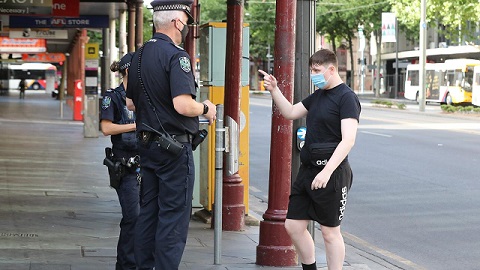
Hello Everyone,
Unfortunately, with all these COVID-19 Interruptions we couldn’t proceed with our end of year get together. This will happen, and during the week a new date will be set. Most likely a Friday evening. Hope this works for you all.
While all these changes are going on, we need to be aware that the communal health is more important than our own convenience. This has been shown in other countries. Here in Australia, it has happened to other States. We certainly do not want to follow the example of countries like the United States and many countries in Europe.
It is now Saturday, 21 November. Yesterday, we were informed that there was some mistake in the information presented to the authorities. So, the lockdown will end at midnight tonight. Instead of being six days, it will now be only three days.

There seems to be no sensible reason for the changes. In many businesses, people are frustrated and have lost a good deal of money over this mistake. It appears that someone gave incorrect information.
The public were beginning to buy up big on toilet paper and other essential commodities as they did in the earlier occasions. Now there is a rush to get things up and running again. I feel for the business people who have suffered enough over the past couple of months. Now they are having to work overtime to get things ready to open tomorrow, Sunday.
It is still quite an eerie feeling about the silence in the district. I do hope that we have learned something from this turne around.
What have I learned?
The peacefulness that comes with the silence in the whole district is some that I have come to appreciate. In the silence, I have become more attentive to my own inner needs. I am beginning to appreciate that silence is a wonderful positive sign in our world today. We need to embrace it as a friend.
There must be some really important things happening in our world that need our attention. Looking out on our troubled world, we can appreciate the needs of others in our lives. As Pope Frances constantly reminds us: The poor need our attention. We need to reach out to them.
At the same time, Pope Francis keeps reminding the world of our need for prayer. Only last week, he remarked that some are saying he is talking too much about prayer. Then he reminded us that prayer was at the heart of our getting to know the Lord and Master of the Universe.

‘Prayer is the centre of life.’ He made this comment in his talks on the Psalms which he started in May and he has now returned to speaking about prayer as we still face issues with Covid-19.
There must be other important things that I have not attended to. I am writing this from a very personal perspective.
We will be opening the doors of the church tomorrow
It would be interesting to hear what others have experienced during this time.

Jodie Scott (Nicholls) was a student at Monivae when I was there. Her medical condition has kept us in contact for many years. She now lives near Geelong.
Hi Noel,
Thanks for your news.
I think that the silence is the best, it's beautiful and allows time for reflection. The world has grown too used to being constantly entertained in my eyes.
As Victoria has had strict lockdown for 7 months on and off, I have to say that I prefer it with restrictions lol. There were no colds over winter, I could smell the earth, see the sky over the closest city, there were less cars on the road and less pollution, our garden had more veggies than ever. We are now just coming out of restrictions and the traffic is unbearable, the tourists are in their thousands, prices at the supermarkets and petrol stations are high again.
The lock down has been an amazing eye opener for children who have mostly grown up not knowing that the sky is clear blue and the sides of the road have no rubbish, I have welcomed this "tune up" with the earth and the groundedness that it has provided.
Jodie
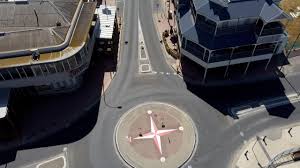
Life At Little Sisters of the Poor, Randwick,Under Covid-19. Greg McEnnally msc
Life At Little Sisters of the Poor Under Covid-19. Greg McEnnally msc

Life is full of surprises. When someone says “I am going to do …”, God laughs. We do not know the future and if we had any doubts about this before, surely Covid-19 has put an end to them. Probably nobody could have predicted this pandemic and how it would pan out – medically, geographically, economically, and politically.
I have been chaplain to the Little Sisters of the Poor Nursing Home in Randwick since 2014, each day driving the 3.5 km from the Sacred Heart Monastery at Kensington to the Little Sisters, and back. By March, 2020, Covid-19 had arrived.
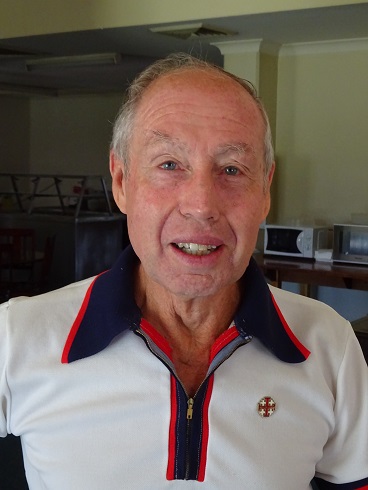
The monastery, where most of the residents are elderly, went into lock-down. The Little Sisters, where all residents are elderly, also went into lock-down. What to do? It seemed logical that I shift my residence to the Little Sisters. They were amenable and they expressed utter delight! Did they really know what they were getting?? – charitable community, these Sisters. I moved in at the end of March, taking with me only what I would need. Now they could be assured of daily Mass, and it is an honour for me to be able to provide this.

Residents remain in the house, going out only for medical appointments, shopping or exercise. If a resident needs to go to hospital, then he/she needs to be tested for Covid-19 and to spend 14 days in isolation upon return. This can be irksome. If the residents need to do shopping often other people can do it for them.
On one occasion the Sisters did a lot of shopping for general items, which went on display: people could take whatever they needed. A fantastic initiative, indicative of the real caring spirit of these Sisters. I doubt if many other nursing homes came up with this service. As regards exercise, I certainly relish the opportunity each afternoon, either to swim, walk or bike ride. Once a month I take a day off to go walking sections of the Great North Walk up near the Hawkesbury.
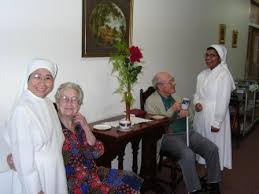
Anybody coming into the Home must first have had a flu injection. Hand sanitisers are available in the foyer and throughout the home and temperature is taken upon entry. This could be rather amusing during the winter months when skin temperature can be lowered by cold air, registering perhaps 34 degrees; “but I am still alive”! Staff members wear masks, as do the Sisters and I when around the residents. Social distancing is so important.
This social distancing requirement has the unfortunate corollary of limiting visitors, which can be rather hard both on the family and on the resident, especially so when there is some cause for celebration, such as a birthday. One of the important practices here is to celebrate birthdays, as a way of recognising the uniqueness and value of each person.
At lunch the birthday person receives a bunch of flowers, a card and a cake with a candle. The Birthday Quartet then sings Happy Birthday, together with everyone else. This famous quartet includes yours truly, preparing of course to trip the light fantastic. It also includes a resident who is a member of the Sydney Male Choir, so at least one of us can actually sing. We all have fun.
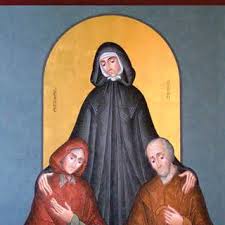
Father’s Day should be happy but can be sad when the family must keep their distance. We made a special effort at Mass and afterwards at lunch. Those fathers (grandfathers and great grandfathers) who could were placed in a separate room, with suitable decorations and a parcel of presents for each man. It was a special meal. I applaud these initiatives.
When a resident is dying, then the family do come in, after due precautions, including wearing protective clothing. Otherwise family members can talk with their loved ones through a glass window: sad, but necessary. At least they can see each other. The home to date has not had a single case of Covid-19, and we want to keep it that way.

A Tiwi Islands, MSC, culture story, John Fallon MSC. Part 2, Pukumani Ceremonies condemned or accepted
A Tiwi Islands, MSC, culture story, John Fallon MSC. Part 2, Pukumani Ceremonies condemned or accepted
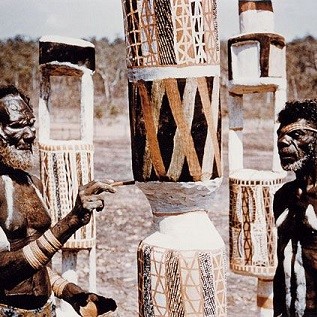
Creative Accommodation?
These histories of conversion by creative accommodation of Christianity are becoming so common as to be a new orthodoxy. And it could be said that this global pattern included the efforts of missionary priests on the Tiwi Islands who, in the wake of the Second Vatican Council, turned to the Pukumani ceremony to "inculturate" the faith for the Tiwi. Looking at the missionary archive alone might give historians such an impression.
But after meeting the Tiwi, my concern is of the potential of the "creative accommodation" model of Indigenous conversions to overshadow Aboriginal people's own conceptions of their histories, imposing non-Indigenous categories on Indigenous experiences. In speaking with Tiwi people, I hope to understand Indigenous histories on their own terms, not through the lens of their colonisers, and to view Aboriginal peoples as full historical agents, not merely as reactors or resistors to Europeans.
And "mutual conversion" is not how the Tiwi tell their history of Christianity, nor do they emphasise creative incorporation of a new faith into their culture. Instead, according to Tiwi people, they have long been Catholic. Tiwi narratives of conversion insist that the Church did not perceive their faith until the intervention of their spirits. Their spirits ruptured the priest's understanding when, in a moment of crisis, Fallon turned to Tiwi ritual knowledge for safety, calling to the Tiwi elders for help. In this moment, the Tiwi elders ministered to the wayward Fallon. They modelled Christian virtues to the priest who learns to confess, do penance and convert to Tiwi culture.
Whereas priests were proud of their progressiveness to reach Indigenous souls, Tiwi interpretations disrupt and overturn this vision of inculturation. For them, priests' attempts to accommodate them was, in fact, appropriate submission to their elders and spirits. As another Tiwi woman told me, "if you want someone to follow your religion, you've gotta come to them."
Reconciling Pukumani
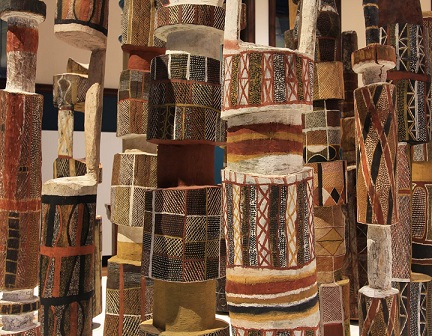
Tiwi culture is known for the Pukumani poles: unique grave posts central in Tiwi mortuary rituals. When someone dies, they become a mobuditi. Mobuditis are so light they can walk on water. They linger where the person once lived or where their body lies. They can be dangerous: if lonely or upset, they might kill. Tiwi people practice elaborate rites to assist the mobuditi. These are also incredible displays of Tiwi art, dance and music - including the Pukumani poles.
Pukumani also refers to the complex of ritual mourning, given to the Tiwi by their creator-ancestor, Purrukapali. On the death of Purrukapali's son, his rival, the Moon-Man (Tjaparra), offered to bring the boy back to life on the third day (just as the moon reappears every month). Purrukapali refused, declaring "you must all follow me; as I die, so you all must die." He carried the child's body into the water, where he joined his son in death. Purrukapli's choice means all Tiwi must follow Purrukapali; all will die.
As the mission consolidated its presence in the first half of the twentieth century, it took harsher measures against "pagan" elements of Tiwi culture. Old people tell me they resented being forbidden from visiting the "pagans" - that is, their relatives who camped nearby. They also resent they were not allowed to attend ceremony as children.
The missionary concern was not arbitrary; Pukumani could have disturbing meanings when translated into their own theological understandings. When, by the late 1960s, Tiwi people recounted the story using Christian terminology - saying, "we shall all follow [Purrukapali] all of us down into hell" - it is likely missionaries understood the Pukumani ceremony as a rejection of the Christian heaven.
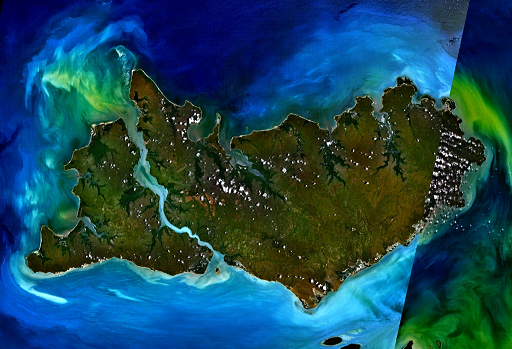
The missionaries drew connections between Christ's resurrection and the Pukamuni ceremony. When offered the hope of resurrection, Purrukapali stubbornly refused: he seemed an archetypal pagan. For Catholic priests, Purrukapali's role in Tiwi cosmology must be that of Adam or, perhaps worse, Satan himself. A ceremony following Purrukapali's command, seemingly damning all Tiwi to death or even hell, was deeply disturbing and spiritually dangerous.
So how did the Pukumani and Catholic church reconcile? Barry Puruntatameri was one among many who retold the pivotal event:
"Some Tiwi, Tiwi was working with the missionary. And he saw the big mob. He look in the bushes here ... and it was on Sunday. Sunday was big ceremony, biggest ceremony they had: Pukumani. This Tiwi guy, he went down and he said, 'Oh, I gotta go tell the priest'. He went down and he saw the father. He said, 'Father there is big ceremony, Pukumani in the bush'.
"And he said, 'Where?'
"'In the bushes' ...
"Everyone was dancing, clapping, everyone dancing. Few of those men saw it, you know, was coming. He just walked gently, but they didn't see him. And he was right behind them, watching. Next thing they saw and he just bolted through here. They all just ran out in the bush, they went and left the ceremony. He went and threw that Pukumani, he knocked it down, Pukumani pole.
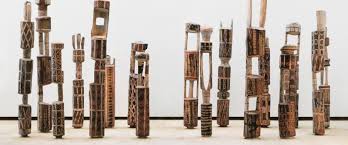
"And after that, after that, he went across to Melville and he had an outboard motor, he was going to make mass to the other community, on Milikapiti. Anyway, that boat engine came out. It went under the water. That was punishment for that."
As he went on his rampage, the old people cautioned Fallon that he was making a mistake. Some had been forewarned in a dream: Father
"Those old people said to him, 'something got to be happen to you' and he came across by boat and he try start that engine then he run right in the middle of the water to stop. That engine stopped."
The old people sat on the shore, waiting for Fallon to call for help. Though the priest had wronged them, they were not angry because he knew not what he did:
"He came and shook the cemetery pole. The old people weren't angry, they weren't. They were sitting with spears and fighting club, but they knew it was because the mission didn't understand."
The mobuditi, disturbed by the priest's toppling of the poles, was "cheeky," sabotaging the outboard motor (remember, moboditis can walk on water). Another storyteller told me how the boat began to sink, the priest nearly drowned, "that's when he called out for help. 'Help! Help!'" before Tiwi people rescued him.
The story is reminiscent of St. Peter's attempt to walk on water. Fallon had no faith in Tiwi culture, so he sank down, saved only when he turned to the Tiwi. But the story is also reminiscent of Purrukapali himself. Not realising he was in the danger from the angered mobuditi, Fallon was inadvertently following Purrukapali to a watery grave. When Fallon turned and accepted Tiwi help, he experienced a resurrection like that the Moon-man offered, choosing to follow a better way.
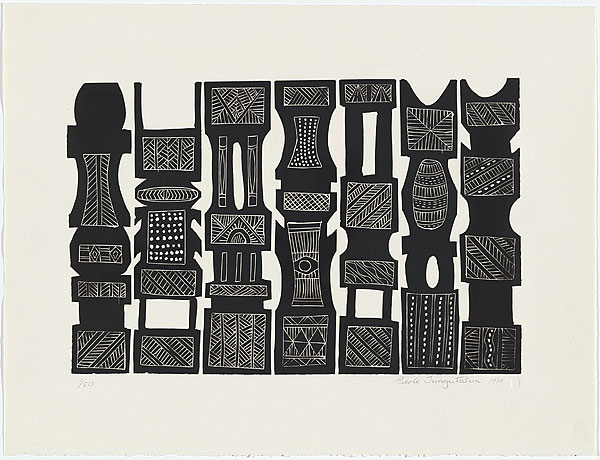
The story continues: the offending priest saw his error and repented. "After that, maybe six months later, one year later he apologises." Using the genre of Christian conversion stories, but applying these to the priest and the Church, Tiwi people demonstrated in their story telling their Christian understanding. In a role-reversal, the Tiwi people pronounced forgiveness on the repentant priest:
"He said sorry to our older people. He went back, the next day he went back. 'Sorry, sorry, but I know', you know, 'God gave you your culture and like Christian way'."
Tiwi people remember teaching the priest the meaning of ceremony and about the truths of the spiritual world. Not only did the priest repent of his actions but was "converted" to Tiwi tradition:
"They brought him back here to Bathurst [Island] and they explain to him. 'What you did back there was wrong. You shook the poles and knocked the pole over. That's why the spirit got you. What we did back there, we wasn't worshipping evil, we were having ceremony for a deceased person, a family member. That's why when you shook the poles and you got in the middle, the spirit got you.' That motor went underwater, the bung went missing. That's when he believed in our culture."
The priest's error was not mere disrespect, but failing to understand that this Pukumani ceremony was, for Tiwi people, not pagan but a Catholic ceremony. Fallon had said "you all pagan mob," but he was mistaken. Tiwi people had a broader vision of what could be authentically Catholic:
"He just knocked all the ceremony poles. It was very wrong because that's the culture ... I don't know why, but he knocked all the poles. He wouldn't accept it. He thought we were all pagans. But we were baptised. We were Catholics."
Fallon's conversion was, for the Tiwi, the catalyst for a change throughout the diocese and Church. After his apology to the Tiwi, in an act of penance, he wrote to the bishop:
"[Fallon] write a letter to bishop: 'We should leave this cultural thing. That's their culture. They believe in their culture.' Bishop O'Loughlin, yeah, that's him.
"And bishop said, 'All right'.
"He came across and he apologised to all the Tiwi. The bishop apologised. He apologised to Tiwi. He said, 'I didn't know that you had a cultural, a cultural ceremony'."
The archives suggest that this conversation with the bishop took place over many years. In 1967, the Bishop of Darwin, J.P. O'Loughlin, still held that it was doubtful if an Aboriginal person, "thoroughly indoctrinated in his stone age philosophy" by participating in ceremonies could ever "make a success of life in the 20th Century." A Tiwi man corrected him, explaining that they had reached an agreement with Fallon that "it was possible to follow both the European and Tiwi customs."
After much urging from missionary priests, O'Loughlin established a Mission Board in 1968, consisting of priests, nuns, Aboriginal representatives and himself (previously the bishop alone controlled the missions). It went on to promote greater engagement with Tiwi culture on the part of missionaries including through the Nelen Yubu Missiological Unit, established in 1977.
According to Tiwi storytellers, Fallon influenced the other priests and nuns, instructing them on the importance of respecting Tiwi traditions. For the Tiwi, though Fallon went out to shake and destroy the poles, his experience, in fact "shook" the missionaries. It made them re-think their entire mission strategy.
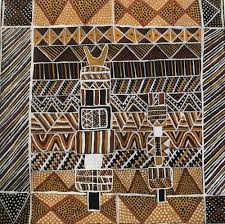
Laura Rademaker is a Postdoctoral Research Fellow in the Australian Catholic University's Institute for Religion and Critical Inquiry, and author of Found in Translation: Many Meanings on a North Australian Mission
